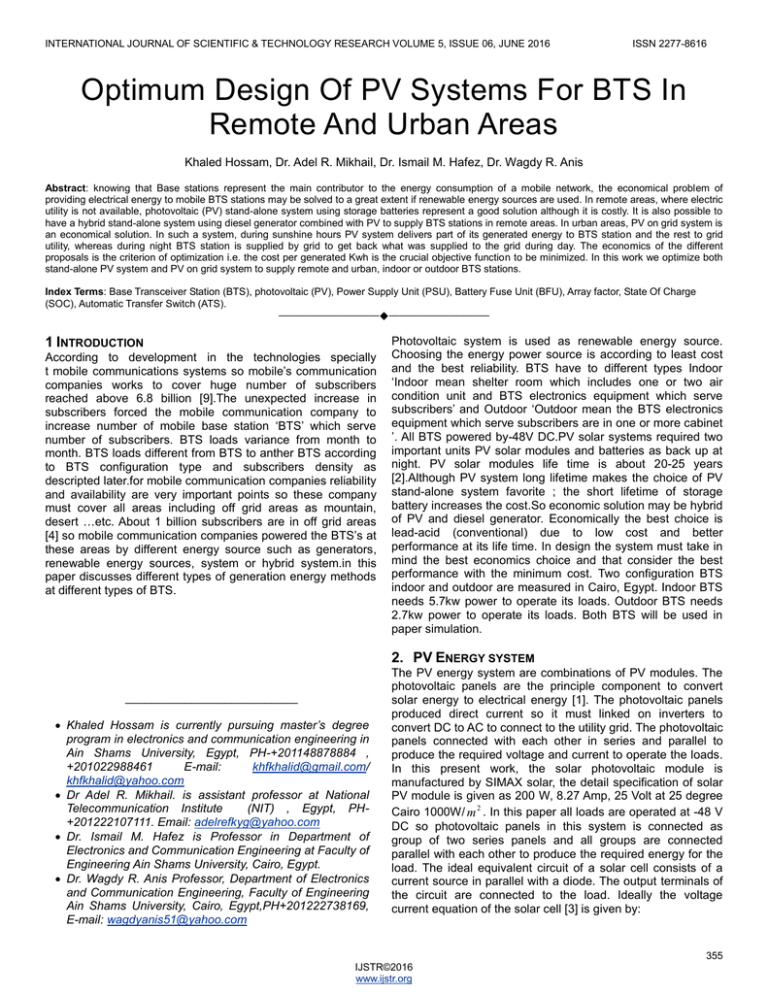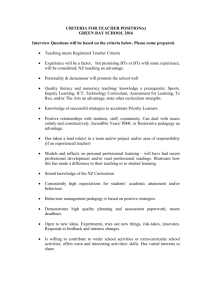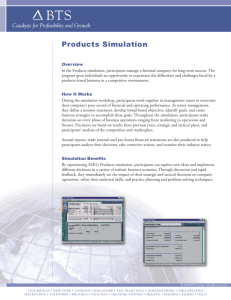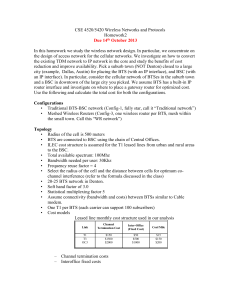Optimum Design Of PV Systems For BTS In Remote And Urban Areas
advertisement

INTERNATIONAL JOURNAL OF SCIENTIFIC & TECHNOLOGY RESEARCH VOLUME 5, ISSUE 06, JUNE 2016 ISSN 2277-8616 Optimum Design Of PV Systems For BTS In Remote And Urban Areas Khaled Hossam, Dr. Adel R. Mikhail, Dr. Ismail M. Hafez, Dr. Wagdy R. Anis Abstract: knowing that Base stations represent the main contributor to the energy consumption of a mobile network, the economical problem of providing electrical energy to mobile BTS stations may be solved to a great extent if renewable energy sources are used. In remote areas, where electric utility is not available, photovoltaic (PV) stand-alone system using storage batteries represent a good solution although it is costly. It is also possible to have a hybrid stand-alone system using diesel generator combined with PV to supply BTS stations in remote areas. In urban areas, PV on grid system is an economical solution. In such a system, during sunshine hours PV system delivers part of its generated energy to BTS station and the rest to grid utility, whereas during night BTS station is supplied by grid to get back what was supplied to the grid during day. The economics of the different proposals is the criterion of optimization i.e. the cost per generated Kwh is the crucial objective function to be minimized. In this work we optimize both stand-alone PV system and PV on grid system to supply remote and urban, indoor or outdoor BTS stations. Index Terms: Base Transceiver Station (BTS), photovoltaic (PV), Power Supply Unit (PSU), Battery Fuse Unit (BFU), Array factor, State Of Charge (SOC), Automatic Transfer Switch (ATS). ———————————————————— 1 INTRODUCTION According to development in the technologies specially t mobile communications systems so mobile‟s communication companies works to cover huge number of subscribers reached above 6.8 billion [9].The unexpected increase in subscribers forced the mobile communication company to increase number of mobile base station „BTS‟ which serve number of subscribers. BTS loads variance from month to month. BTS loads different from BTS to anther BTS according to BTS configuration type and subscribers density as descripted later.for mobile communication companies reliability and availability are very important points so these company must cover all areas including off grid areas as mountain, desert …etc. About 1 billion subscribers are in off grid areas [4] so mobile communication companies powered the BTS‟s at these areas by different energy source such as generators, renewable energy sources, system or hybrid system.in this paper discusses different types of generation energy methods at different types of BTS. Photovoltaic system is used as renewable energy source. Choosing the energy power source is according to least cost and the best reliability. BTS have to different types Indoor „Indoor mean shelter room which includes one or two air condition unit and BTS electronics equipment which serve subscribers‟ and Outdoor „Outdoor mean the BTS electronics equipment which serve subscribers are in one or more cabinet ‟. All BTS powered by-48V DC.PV solar systems required two important units PV solar modules and batteries as back up at night. PV solar modules life time is about 20-25 years [2].Although PV system long lifetime makes the choice of PV stand-alone system favorite ; the short lifetime of storage battery increases the cost.So economic solution may be hybrid of PV and diesel generator. Economically the best choice is lead-acid (conventional) due to low cost and better performance at its life time. In design the system must take in mind the best economics choice and that consider the best performance with the minimum cost. Two configuration BTS indoor and outdoor are measured in Cairo, Egypt. Indoor BTS needs 5.7kw power to operate its loads. Outdoor BTS needs 2.7kw power to operate its loads. Both BTS will be used in paper simulation. 2. PV ENERGY SYSTEM __________________________ Khaled Hossam is currently pursuing master’s degree program in electronics and communication engineering in Ain Shams University, Egypt, PH-+201148878884 , +201022988461 E-mail: khfkhalid@gmail.com/ khfkhalid@yahoo.com Dr Adel R. Mikhail. is assistant professor at National Telecommunication Institute (NIT) , Egypt, PH+201222107111. Email: adelrefkyg@yahoo.com Dr. Ismail M. Hafez is Professor in Department of Electronics and Communication Engineering at Faculty of Engineering Ain Shams University, Cairo, Egypt. Dr. Wagdy R. Anis Professor, Department of Electronics and Communication Engineering, Faculty of Engineering Ain Shams University, Cairo, Egypt,PH+201222738169, E-mail: wagdyanis51@yahoo.com The PV energy system are combinations of PV modules. The photovoltaic panels are the principle component to convert solar energy to electrical energy [1]. The photovoltaic panels produced direct current so it must linked on inverters to convert DC to AC to connect to the utility grid. The photovoltaic panels connected with each other in series and parallel to produce the required voltage and current to operate the loads. In this present work, the solar photovoltaic module is manufactured by SIMAX solar, the detail specification of solar PV module is given as 200 W, 8.27 Amp, 25 Volt at 25 degree Cairo 1000W/ m 2 . In this paper all loads are operated at -48 V DC so photovoltaic panels in this system is connected as group of two series panels and all groups are connected parallel with each other to produce the required energy for the load. The ideal equivalent circuit of a solar cell consists of a current source in parallel with a diode. The output terminals of the circuit are connected to the load. Ideally the voltage current equation of the solar cell [3] is given by: 355 IJSTR©2016 www.ijstr.org INTERNATIONAL JOURNAL OF SCIENTIFIC & TECHNOLOGY RESEARCH VOLUME 5, ISSUE 06, JUNE 2016 I mp I ph Vmp V T Io e 1 10 KVA Diesel generator Diesel generator cost Overhaul and maintenance DG parts Average DG run hr/day Average diesel consumption 20 KVA Diesel generator Diesel generator cost Overhaul and maintenance DG parts Average DG run hr/day Average diesel consumption (1) The power output of solar cell is given by: VT KT q Pmp I mp * Vmp (2) Item PV module Inverter Diesel generator Batteries The array factor FA is defined by Eq.(4) as the ratio between PV array peak power PP and the average load power PL. PP PL (4) The array factor varies from month to month since P L increases during summer. However the energy generated by PV array varies with tilt angle β as shown later. PL is load energy during one day divided by 24 hours (kwh). Array factor ratio ranges between 5 to 10. In every system in this paper β is simulated by using math-lab with two different values β=15 and β=30 to choose the better efficiency in each case. β=30 is the value which used in the design due to better performance at smaller array size comparing with array size when β=15 in Cairo Egypt. Note that latitude of Cairo is 30 oN 3. ECONOMIC CONSIDERATION According to international market price, this study consider the following costs in US dollar $ as shown in Tab.1. Tab. 1 Economics of systems items Type of energy system PV energy source Modules cost per Kwp Mounting cost per Kwp Installation cost per Kwp 20 Kwp Inverter Inverter cost Mounting cost Installation cost Cables per inverter Battery Battery and Mounting cost /Kwh Installation cost Diesel generator Tank 1000 L of fuel cost ATS panel Over all maintenance 1000 hr of running Fuel cost per litter 8750 $ 2875 $ 11.5 hrs/day 1.8 L/hr 11250 $ 3750 $ 11.5 hrs/day 3 L/hr Tab. 2 Average lifetime (3) Where: I0=Array reverse saturation current (A); K=Boltzman constant=1.38x10-23(J/K); Iph=Photo current (A); q=Electron charge=1.6x10-19(C); T=Cell temperature (K); Imp=Max power current of PV array (A); Pmp=Output power of PV array (W); Vmp= Max power voltage of PV array (V); FA ISSN 2277-8616 Cost 700$/Kwp 200$/Kwp 100$/Kwp 3700 $ 1000 $ 550 $ 170 $ 110 $ 5$ 375 $ 1875 $ 300 $ 0.2 $/L Average lifetime 25 years 10 years 12 years 3 years For Diesel generator lifetime measured by 50,000 hours of running in case of running for 11.5 hours/day that make lifetime 12 years. Overhaul and maintenance diesel generator parts dependents on hours running per day. Must Overhaul and maintenance diesel generator parts every two years If diesel generator running more than 8 hr/day[10]. 3.1 Economic calculations Financing the system is assumed to be done by a bank suppose that system cost is P ($) paid at t=0, and this amount is borrowed from a bank. This borrowed is paid back by N equal annual payments each A per year. Eq.(5) shows the relation between P,A,N and interest rate i [8]. P A A A ... 2 1 i 1 i 1 i N P1 i A A A A .... 1 i 1 i 2 1 i N 1 (5) (6) From (6)-(5) we get the following equation 1 1 i N P A* i (7) Where: P=Initial payment at starting moment. A=Installment of payment. i=annual interest rate. N= number of Installments. 1 L M s 1 1 im Pt E * Co im Ls (8) Where: Pt=Total system cost over 25 year. E=Average monthly generated energy (kwh). Co= Selling price per kwh. Ls= Monthly loss in system efficiency. 356 IJSTR©2016 www.ijstr.org INTERNATIONAL JOURNAL OF SCIENTIFIC & TECHNOLOGY RESEARCH VOLUME 5, ISSUE 06, JUNE 2016 ISSN 2277-8616 im= Monthly interest rate. M=Total number of months. In all the following systems the yearly annual loan equal. 11%. Yearly loss in PV efficiency systems equal 2%. 4. ON GRID PV SYSTEM (COMPENSATED SYSTEM) Fig 2. Monthly average daily energy for on gird PV system for indoor BTS Fig 1. Structure on grid PV system In this system BTS powered by two energy sources electrical energy (from Grid utility) and PV energy source. This system works as follows; during morning the BTS take its energy from PV energy source except the time of sunrise and sunset BTS take its energy from the electrical grid and also during the night PV not working according no solar energy is available at night so BTS take its energy from the electrical grid. This system have low batteries created as backup for max 2 hours.As the shown in Fig (1) structure on grid PV system. The on grid PV system is combination of solar-PV array modules which generating direct current (DC), utility electric grid energy source which generating alternated current (AC) when PV energy unavailable, control circuit 1 which decides if system operating by PV energy source or Electric utility energy source,DC line which accumulates all DC sources to the rectifier backplane, PSUs which convert the AC power source to DC power source to be operating in rectifier backplane, BFUs which control charging and discharging the batteries string,BTS loads which including all DC loads communication equipment‟s and DC air condition in case of indoor BTS, control circuit 2 which pass the extra energy which generated from PV energy source to the inverters, inverters which convert the DC current to AC current and finally utility grid out which measured by electric power meter to calculated the generated energy from this system. 4.1 ON GRID PV Systems for Outdoor and Indoor BTS In this system is simulated by using math-lab for both type of BTS indoor and outdoor BTS. This simulation is pointed per month as average energy per year. The following figures Fig.4 and Fig.6 show the Energy generated by solar cell, Energy to operating the loads and AC energy delivered to the utility grid. Array factor curve for both types of BTS as shown in Fig.3 and Fig5. Fig 3. Array factor per month for on gird PV system for indoor BTS Fig 4. Monthly average daily energy for on gird PV system for outdoor BTS As shown in Fig 3 and Fig 5 β=30 is better efficiency than β=15 with fixed PV array size. If β=15 is applied that will increase PV array size with the ratio between two curves β=15 and β=30. This ratio is variance according to BTS configuration type and proposed system which used. This variance is showed later in next proposed systems. 357 IJSTR©2016 www.ijstr.org INTERNATIONAL JOURNAL OF SCIENTIFIC & TECHNOLOGY RESEARCH VOLUME 5, ISSUE 06, JUNE 2016 ISSN 2277-8616 storage.The batteries string size is very large to cover all night and one cloudy day. The stand-alone system is combination of solar-PV array modules which generates direct current (DC), DC line which accumulates all DC sources to the rectifier backplane, BFUs which control charging and discharging the batteries string and BTS loads which including all DC loads communication equipment‟s and DC air condition in case of indoor BTS.. Structure of stand-alone system shown in Fig.(6). Fig 5. Array factor per month for on gird PV system for outdoor BTS 4.2 Economics on gird PV systems. In this system the best design as increasing the number of PV array modules to sell the exceeding energy to the grid and buy the electrical energy from the grid at night with the same cost which sold to the grid that make the total cost of this is zero. The major cost in this system in the initial cost. Batteries in the system works as backup. If electrical energy source or PV solar energy source was down for max two hours. In this system has PV solar modules, inverters, ac power cables connected to grid, aluminum plates to fixed PV solar modules and dc power cables to connect PV solar modules as array with each other to the load. Total cost of this system is calculated for both BTS type during lifetime 25 year.as shown in Tab. 3 Tab. 3 Economics calculated in Dollar on grid PV systems Element Average BTS load Power PV array size Batteries size Array factor PV modules and its supports Initial inverter and cables cost Total inverter and cables cost Initial batteries cost Total batteries cost Total system cost Cost of energy Outdoor BTS Indoor BTS 2.7 kw 5.7 kw 14 Kwp 100 AH 5.18 28 Kwp 250 AH 4.91 14,000 $ 28,000 $ 5,420 $ 10,500 $ 10,294 $ 18,923 $ 552 $ 1930 $ 26,224 $ 0.1 $/kwh 1380 $ 6213 $ 53,135 $ 0.1 $/kwh 4.3 Advantage and disadvantage on grid PV systems Advantage of this system is the minimum cost of energy also when cloudy day incident the system operated the loads from utility energy source. Total energy wasted cost in system equal zero. The major disadvantage in this system appear when ac power source not worked at night or during cloudy day more than two hours that will make all system down till the electric energy source working again. Also to apply this system the electric utility grid must be available so this system can‟t be applied at isolated areas. Fig 6. Structure of stand-alone system 5.1 Stand-alone Systems for Outdoor and Indoor BTS In this system is simulated by using math-lab for both type of BTS indoor and outdoor BTS. This simulation is pointed per month as average energy per year. The following figures Fig.7 and Fig.10 show the Energy generated by solar cell, Energy to operating the loads. SOC of batteries string during the year is showed in Fig.9 and Fig.12. Array factor curve for both types of BTS as shown in Fig.8 and Fig.11. Fig 7. Monthly average daily energy for Stand-Alone system for indoor BTS 5. STAND-ALONE SYSTEMS In this system there only solar energy source which generated from PV array modules. In day the solar energy source operates the BTS loads and charging the batteries string. In night and at cloudy days solar energy source is unavailable so that this system depends on the batteries strings as a 358 IJSTR©2016 www.ijstr.org INTERNATIONAL JOURNAL OF SCIENTIFIC & TECHNOLOGY RESEARCH VOLUME 5, ISSUE 06, JUNE 2016 ISSN 2277-8616 Fig 12.. SOC per year for Stand-Alone system for outdoor BTS Fig 8. Array factor per month for Stand-Alone system for indoor BTS Fig 9. SOC per year for Stand-Alone system for indoor BTS As shown in Fig 9 and Fig 12 in cloudy days the SOC decrease to 20% due to discharge operation and ripples in curve present the cloudy days. Then increasing to 90 % due to charging operation. As shown in Fig 7 and Fig 11 there is a gap between the solar energy generated by PV system and the energy to operate the load and that because the power loss in charging and discharging the batteries string also in case of the next day is may be cloudy. 5.2 Economics for Stand-Alone systems In this system the best design as increasing the number of PV array modules to cover the BTS loads and the batteries strings which could operates BTS load for 36 hours. In this system the is better choice for batteries is Lead-acid (conventional) because of its minimum cost. Although design the system to link the SOC of the batteries in range of 20% to 90%[5] to save the batteries life and that between 3-4 years. In this system have PV solar modules, aluminum plates to fixed PV solar modules, Batteries strings and dc power cables to connect PV solar modules as array with each other to DC line. Total cost of this system is calculated for Both BTS configuration during life time 25 year.as shown in Tab. 4. Table. 4 Economics calculated in Dollar for Stand-Alone systems Fig 10. Monthly average daily energy for Stand-Alone system for outdoor BTS Element Average BTS load Power PV array size Batteries size Array factor PV modules and its supports Initial batteries cost Total batteries cost Total system cost Cost of energy Outdoor BTS Indoor BTS 2.7 kw 5.7 kw 18Kwp 3000AH 6.67 36Kwp 6000AH 6.31 18,000 $ 36,000 $ 16,560 $ 57,924 $ 75,924 $ 0.29 $/kwh 33,120 $ 115,849 $ 151,750 $ 0.3 $/kwh 5.3 Advantage and disadvantage for stand-Alone systems Advantage of this system is that it can be applied in any isolated area. The main disadvantage of this system is the high cost of batteries because of its short lifetime (3years).This makes the overall system cost high. Fig 11. Array factor per month for Stand-Alone system for outdoor BTS 6. HYBRID PV AND DIESEL GENERATOR SYSTEM In this system the BTS load is operated by two different energy sources solar and generator. At day the BTS loads operated by solar energy source. And at night and cloudy days BTS loads operated by generator energy source. The hybrid PV 359 IJSTR©2016 www.ijstr.org INTERNATIONAL JOURNAL OF SCIENTIFIC & TECHNOLOGY RESEARCH VOLUME 5, ISSUE 06, JUNE 2016 ISSN 2277-8616 and diesel generator system is combination of solar-PV array modules which generating direct current (DC), generator energy source which generating alternated current (AC) when PV energy unavailable, ATS which switches between both energy source according to time duration and PV availability source,DC line which accumulates all DC sources to the rectifier backplane, PSUs which convert the AC power source to DC power source to be operating in rectifier backplane, BFUs which control charging and discharging the batteries string and BTS loads which including all DC loads communication equipment‟s and DC air condition in case of indoor BTS. Fig 15. Array factor per month for Hybrid PV and generator System for indoor BTS Fig 13. Structure of Hybrid PV and generator system 6.1 Hybrid PV and generator Systems for Outdoor and Indoor BTS In this system is simulated by using math-lab for both type of BTS indoor and outdoor BTS. This simulation is pointed per month as average energy per year. The following figures shown in Fig.14 and Fig.16 the Energy generated by solar cell, Energy to operating the BTS loads, Energy generated by generator and total energy of solar and generator energy sources. Array factor is shown in Fig.15 and Fig.17. Fig 16. Monthly average daily energy for Hybrid PV and Generator system for outdoor BTS Fig 17. Array factor per month for Hybrid PV and generator System for outdoor BTS Fig 14. Monthly average daily energy for Hybrid system for Indoor BTS 6.2 Economics for Hybrid PV and generator system. In this system ATS takes time to start up the generator so the design choices is adding little amount of storage batteries strings to operating the BTS loads in the period between switching between the both energy source. Although these batteries strings worked as a backup for max four hours. Generators need to maintenance several times that make batteries strings storage bigger twice than on grid PV system as shown in Tab3. 360 IJSTR©2016 www.ijstr.org INTERNATIONAL JOURNAL OF SCIENTIFIC & TECHNOLOGY RESEARCH VOLUME 5, ISSUE 06, JUNE 2016 Tab.5 Economics calculated in Dollar for Hybrid PV and generator systems Element Average BTS load Power PV array size Batteries size Array factor Diesel generator capacity Initial diesel generator & ATS cost Total diesel generator & ATS cost PV modules and its supports Initial batteries cost Total batteries cost Total system cost Cost of energy Outdoor BTS Indoor BTS 2.7 kw 5.7 kw 8 Kwp 300 AH 2.96 16 Kwp 500 AH 2.80 10 kVA 20 kVA 11,000 $ 13,500 $ 70,137 $ 85,514 $ 8,000 $ 16,000 $ 1656 $ 5793 $ 83,930 $ 0.31 $/kwh 2760 $ 10,251 $ 111,770 $ 0.21 $/kwh In case of Outdoor BTS in this system the cost of energy in kwh is huge compared with Indoor BTS according to lower efficiency of using fuel in DG compared with Indoor BTS. As shown in Tab. 1. 6.3 Advantage and disadvantage for Hybrid PV and generator system. Advantage of this system is dependency on itself as control both energy sources. Also this system can be installed anywhere. Disadvantage of this system are a lot. Need fuel and maintenance for generator every month and overhaul and maintenance DG parts is needed every several years according to DG running time . After several years generator needs to change with new one that adding extra cost at this system. Because of generators maintenance and stop of running that make system required batteries strings operating BTS loads for four hours and that add extra cost to this system. ISSN 2277-8616 energy for night duration. The of Stand-alone and generator running at cloudy days system is combination of solar-PV array modules which generating direct current (DC), generator energy source which generating alternated current (AC) when cloudy day is exist, Control unit which decides to running generator energy source,DC line which accumulates all DC sources to the rectifier backplane, PSUs which convert the AC power source to DC power source to be operating in rectifier backplane, PSUs which convert the AC power source which generating from generator to DC power source to be operating in rectifier backplane,BFUs which control charging and discharging the batteries string and BTS loads which including all DC loads communication equipment‟s and DC air condition in case of indoor BTS. 7.1 Stand-alone and generator running at cloudy days systems for Outdoor and Indoor BTS In this system is simulated by using math-lab for both type of BTS indoor and outdoor BTS. This simulation is pointed per month as average energy per year. Fig.19 and Fig.22 show the Energy generated by solar cell, Energy to operating the BTS loads and Energy generated by generator. SOC curve during the year shows in Fig.21 and Fig.22.Array factor is shown in Fig.20 and Fig.23. Fig 19. Monthly average daily energy for Stand-alone and generator running at cloudy days system for Indoor BTS 7. STAND-ALONE AND GENERATOR RUNNING AT CLOUDY DAYS SYSTEM. Fig 20. Array factor per month for Stand-alone and generator running at cloudy days system for Indoor BTS Fig 18. Structure of Stand-alone and generator running at cloudy days system. In this system BTS loads are operated by solar energy source during the year except the cloudy days the BTS loads are operated by generator.In day solar energy source operates BTS loads and charging the batteries strings to store the 361 IJSTR©2016 www.ijstr.org INTERNATIONAL JOURNAL OF SCIENTIFIC & TECHNOLOGY RESEARCH VOLUME 5, ISSUE 06, JUNE 2016 ISSN 2277-8616 7.2 Economics for Stand-alone and generator running at cloudy days systems for Outdoor and Indoor BTS In this system the storage batteries strings decrees by half than stand-alone system that decreasing the cost of the system. The batteries storage size is chosen to operating BTS loads during year with SOC ratio between 20% to 90%. Tab. 6 Economics calculated in Dollar for Stand-alone and generator running at cloudy days systems Fig 21. SOC per year Stand-alone and generator running at cloudy days system for Indoor BTS Fig 22. Monthly average daily energy for Stand-alone and generator running at cloudy days system for Outdoor BTS Element Average BTS load Power PV array size Batteries size Array factor Outdoor BTS Indoor BTS 2.7 kw 5.7 kw 18 Kwp 1400 AH 6.67 36 Kwp 2800 AH 6.31 Generator capacity Initial diesel generator & ATS cost Total diesel generator & ATS cost PV modules and its supports Initial batteries cost Total batteries cost Total system cost Cost of energy 10 KVA 20 KVA 11,000 $ 13,500 $ 14,134 $ 19,125 $ 18,000 $ 36,000 $ 7,728 $ 27,031 $ 60,090 $ 0.21 $/kwh 15,456 $ 54,063 $ 108,552 S 0.19 $/kwh 7.3 Advantage and disadvantage for Stand-alone and generator running at cloudy days systems. Advantage of this system is the storage of batteries strings decreases by half than stand-alone system. Generator running for few days that less the expensive of fuel, maintenance and no needed for changing the generator. Although this system can operates the BTS loads during two or three consecutive cloudy days. Disadvantage of this system is high cost comparing with on grid connected system. 8. CONCLUSION Fig 23. Array factor per month for Stand-alone and generator running at cloudy days system for Outdoor BTS For urban areas, the optimum economic solution to power BTS station is a hybrid system consists of PV system and grid utility. Whereas for rural areas the optimum economic solution is the hybrid PV and diesel generator since it allows more than one cloudy day. Tab.7 Comparison between systems cost in Kwh System On grid PV system Stand-Alone system Hybrid PV and generator system Stand-alone and generator running at cloudy days system Outdoor BTS 0.1 $/Kwh 0.29 $/Kwh Indoor BTS 0.1 $/Kwh 0.3 $/Kwh 0.31 $/Kwh 0.2 $/Kwh 0.21 $/Kwh 0.19 $/Kwh 9. REFERENCES Fig 24. SOC per year Stand-alone and generator running at cloudy days system for Outdoor BTS As shown in fig 21 and fig 24 the batteries strings storage cover the BTS loads during the year and SOC didn‟t decrease than 20% during the year. [1] Pragya Nema, R.K.Nema and Saroj Rangnekar “PV-solar /wind hybrid energy system for GSM/CDMA type mobile telephony base station. “, International Journal of Energy And Environment, Vol. 1, pp. 359-366,2010. [2] Dike U. Ike,Anthony U. Adoghe and Ademola Abdulkareem 362 IJSTR©2016 www.ijstr.org INTERNATIONAL JOURNAL OF SCIENTIFIC & TECHNOLOGY RESEARCH VOLUME 5, ISSUE 06, JUNE 2016 ISSN 2277-8616 “Analysis Of Telecom Base stations Powered By Solar Energy”, INTERNATIONAL JOURNAL OF SCIENTIFIC & TECHNOLOGY RESEARCH.,Vol. 3,pp. 369-374, April 2014. [3] Pragya Nema, “Noble approach of power feeding for cellular mobile telephony base station site: Hybrid energy system.”, International Journal of Energy and power Engineering, Vol. 3, No. 6-2, pp. 7-14,2014. [4] Mohammed H Alsharif, Rosdiadee Nordin and Mohamed Ismail,”Energy optimization of hybrid off grid system for remote telecommunication base station deployment in Malaysia. ”, EURASIP Journal on Wireless Communications and Networking, 2015,DOI 10.1186/s13638-015-0284-7. [5] Ajay Sharma, Anand Singh and Manish Khemariya “Homer Optimization Based Solar PV; Wind Energy and Diesel Generator Based Hybrid System.”,International Journal of Soft Computing and Engineering (IJSCE), Vol.3,pp.199-204 March 2013. [6] Rupendra Kumar Pachuri and Yogesh K. Chauhan,”Hybrid PV/FC Stand Alone Green Power Generation: A Perspective for Indian Rural Telecommunication Systems. ”,International Conference on Issues and Challenges in Intelligent Computing Techniques (ICICT),pp.802-810,978-1-47992900/14/$31.00©2014 IEEE,2014 [7] Andres Kwasinski and Alexis Kwasinski ”Architecture for Green Mobile Network Powered from Renewable Energy in Microgrid Configuration ” IEEE Wireless Communications and Networking Conference (WCNC),pp.1273-1278, 978-1-46735939-9/13/$31.00 ©2013 IEEE,2013. [8] Heineke,J.i “Microeconomics for business decisions, Theory and applications ”, Prentice Hall, Inc. Engle wood cliffs, New Jersey, 1976. [9] International Telecommunication (ITU) statistics database; available: http://www.itu.int.en/ITUD/Statistics/pages/stat/default.aspx, accessed at 23 Nov.2015. [10] Denver, “Maintenance Scheduling for Mechanical Equipment ”, U.S Department Bureau of Reclamation, Facilities Instructions standards and Techniques,Vol.4-1A,Jan 2009. 363 IJSTR©2016 www.ijstr.org






